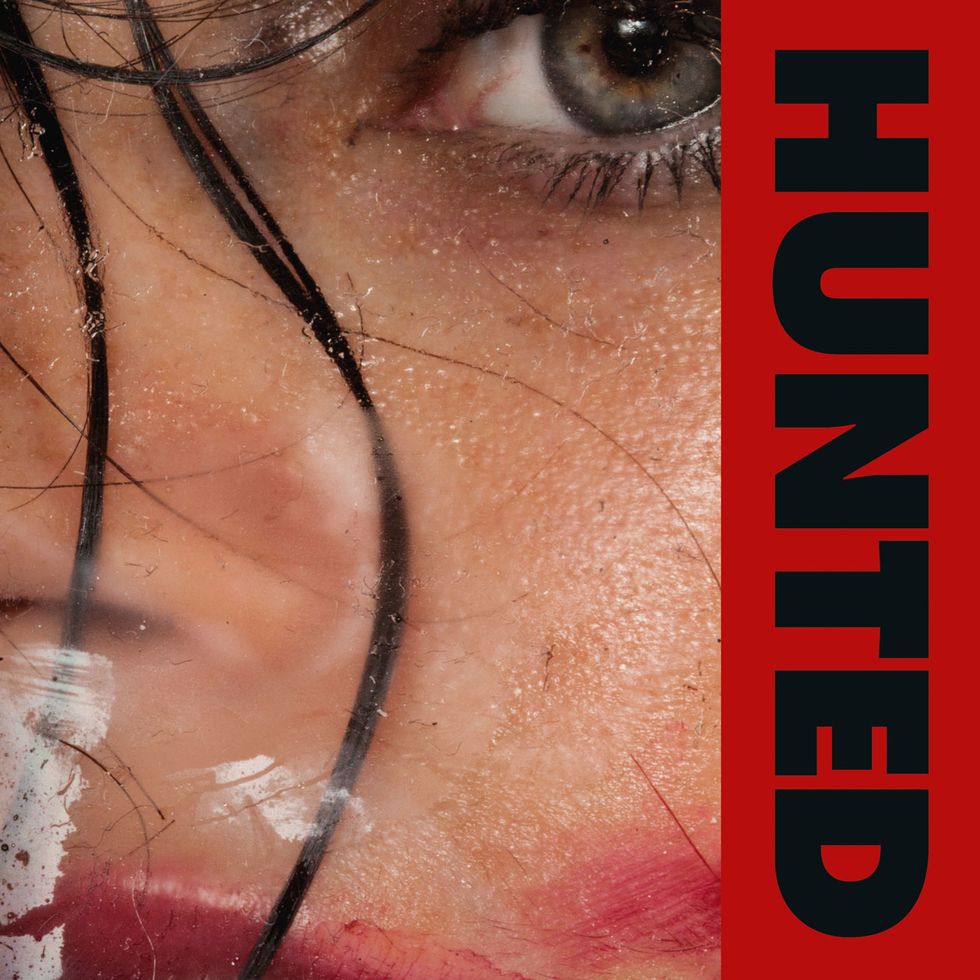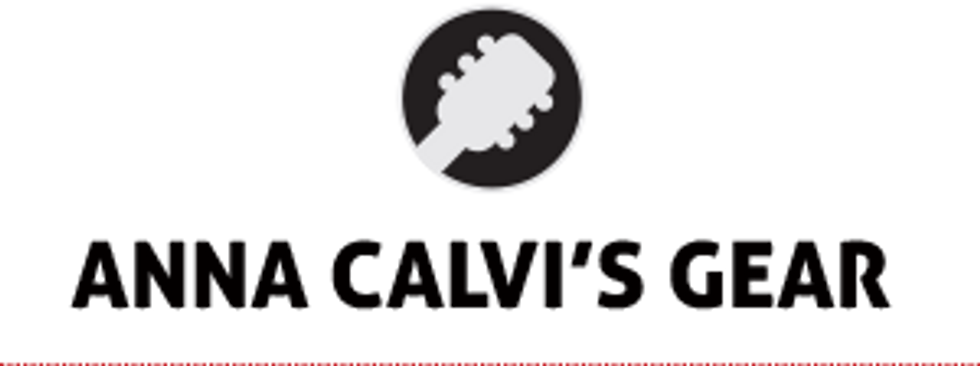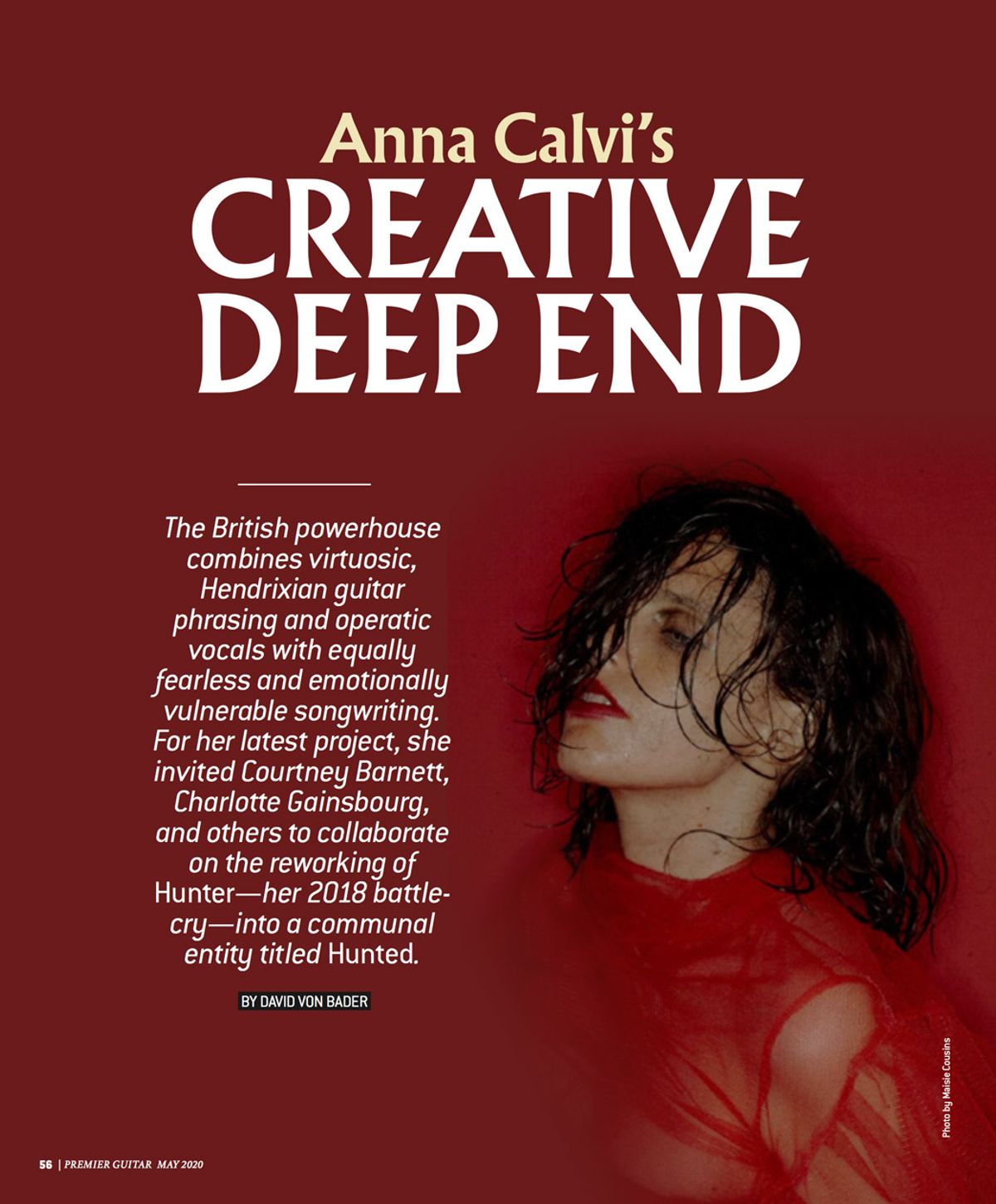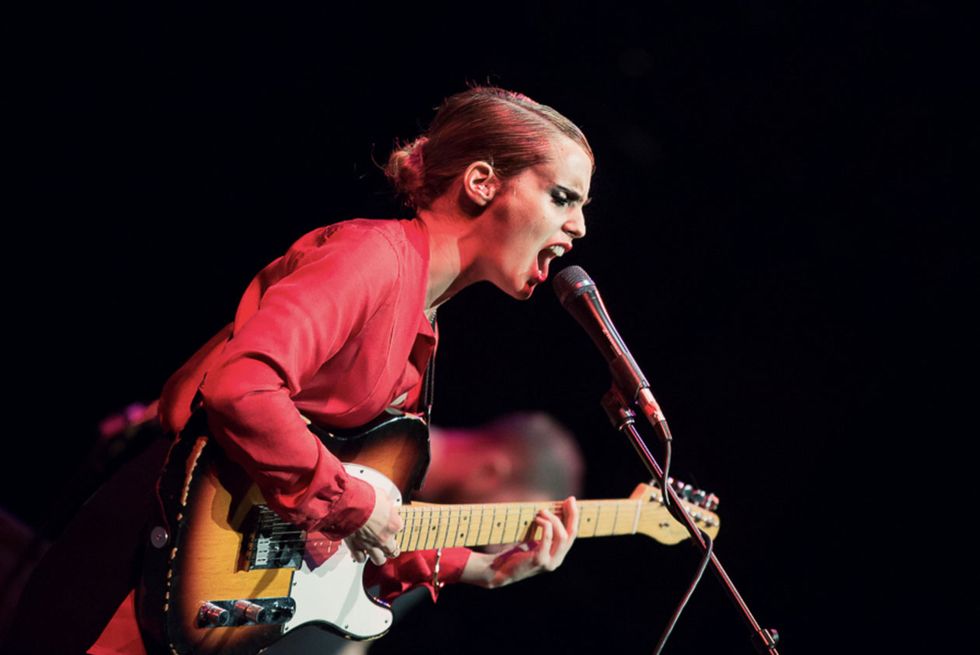“Seeing Women Play Guitar Is—Annoyingly—Still Something of an Anomaly”
British powerhouse Anna Calvi—known for visceral guitar playing and operatic vocals—invites Courtney Barnett, Charlotte Gainsbourg, and others to help rework her 2018 battle-cry, Hunter, into the aptly titled new Hunted.
Anna Calvi’s music lives in the space where emotional fire meets virtuosity and grand vision. The British chanteuse’s records are intense, starkly honest, and laced together with a cohesive aesthetic that touches every aspect of her work. Calvi’s music is difficult to genre-stamp. It juxtaposes sweet melodies and cinematic, Morricone-informed guitar noir against molten feedback and gritty dissonance. Calvi’s music is as enchanting as it is challenging, and yet there’s an undeniable pop sensibility to much of her work, even if the earworms carry heavy topics and wrap them in bold colors. Calvi’s stunning, operatic voice—which has frequently been compared to Edith Piaf’s—leads the charge, but the guitar is her weapon, her dance partner, and her second voice.
With her battle-scarred Fender Telecaster, Calvi has made her way into the collaborative company of such luminary artists as David Byrne, Portishead’s Adrian Utley, and Brian Eno, who mentored her in her early years and once described her as “the best thing since Patti Smith.” The multiple Mercury Prize nominee has been fully embraced by the establishments of high art and high fashion. The singer/songwriter was even called upon to provide the score for the fifth season of the hit TV show Peaky Blinders. As guitar culture’s relationship with its rock ’n’ roll heritage continues to shift and evolve, Calvi represents a new kind of guitar hero: one that channels the drama of the flamenco tradition and the fury and fearlessness of greats like Hendrix into music that’s timeless, dangerous, and progressive.
Calvi studied guitar and violin at university, yet when it comes to her playing, she claims to operate from a purely emotional place. Just the same, her technique is phenomenal: a mélange of blistering linear runs, screaming slide guitar anti-melodies, spaghetti Western twang, and dramatic, Hendrixian feedback and string bending. Calvi also has her own unique circular sweep-picking technique, which she developed from listening to West African guitar music.
Calvi’s performances are ecstatic rituals that live between a rock show and guitar exorcism as performance art. Calvi’s previous LP, 2018’s Hunter, channels the power and dynamism of her stage show into a collection of songs that boldly assert her identity as a queer artist: 10 battle cries of freedom from gender norms. It’s a weighty and personal record that enjoys a lush production from the illustrious Nick Launay (Nick Cave and the Bad Seeds, Killing Joke, Yeah Yeah Yeahs). After Hunter was released, Calvi felt compelled to revisit the early demos that would later become its songs. Finding a certain magic in their sparseness, she gentlyreworked them for her latest album, Hunted, and invited some of her favorite singers (including Charlotte Gainsbourg, Julia Holter, and Courtney Barnett) to add their voices to the music. A reverse remix of sorts, Hunted is a way of transforming a deeply personal work into one of community.
Premier Guitar spoke with Calvi as she prepared for Hunted’s release and her first U.S. tour in years. The soft-spoken musical dynamo opened up about creating Hunter and its companion Hunted, her influences and philosophies as a guitarist, and the idiosyncrasies of her unique world.
Tell us about the Hunted versions of these songs. What motivated you to revisit those demos?
Basically I went back and listened to the first versions of these songs that I recorded when I’d first written them, and I really liked the intimacy and vulnerability they had about them. So I asked some of my favorite singers to add their vocals to these very early recordings. With each song, I kind of already had an idea of whose voice I’d really love to hear on it. I just went for singers that really mean a lot to me, whose voices move something inside of me, and I was lucky enough to get some of my favorite artists, which is pretty incredible.
I think you always gain a lot when you re-record a song that was a demo for an album, but sometimes you do lose some of the magic that happens when you’re on your own and you’ve just written a song and you put it down, when you’re not really worried about anything. It makes it feel natural when you perform it and there is a purity to that which is quite hard to recreate. But I do think both versions have their appealing qualities.
You have a knack for penning simple, yet substantial guitar parts, like the snaky main lick on “Indies or Paradise.” How do you approach writing parts that are simple, but compelling enough to underpin an entire tune?
The main thing is to try to not have your ego involved. There’s kind of this dark desire for all guitar players—including myself—to want to show what you can do. But I think writing good parts is more about showing what you can not do, if that makes sense? To keep it simple and just go with what the song’s asking for is going to be more effective 99 times out of 100. Technicality doesn’t make for very interesting music, most of the time.
Your songs have a lot of drama and sonic cinema, and a lot of that comes from the way your guitar parts build tension in a track. Any advice for adding this to a guitar idea?
For me, the first thing is to get a good reverb pedal or an amp with great reverb. My guitar hero, probably more than anybody else, is Jeff Buckley. The way he played with the reverb on his guitar I always found very dramatic. He’s why I got a Telecaster and why I started playing with reverb in the first place. It sounds like such a simple thing, but I find it brings out the cinematic quality of the guitar and really makes the guitar sing. And I guess my other main influences are quite cinematic: I love Ennio Morricone and the guitar work in his pieces. I’m always really trying to tell the story with the guitar, and I imagine my songs like mini films. That very much informs how I approach the guitar, with a sense of story in mind.
When Hunter came out, you said that a major part of your process was asking yourself if a guitar part fully expressed something emotional. But you’re also a very technically skilled player, so how do you reconcile those two sides when you’re writing?
I’m not really thinking about technique at all when I play, I’m thinking emotionally entirely. When I start to put a part together, I’ll tilt my head back while playing to make sure I’m not staring at the fingerboard. That makes me go to new places, where I’m reaching out and hoping to find a note that does something for me.

TIDBIT: On her latest album, Hunted, Anna Calvi revisited early demos from Hunter, her intensely personal 2018 release, and invited some of her favorite singers to record vocals over them.
I’ve seen your pedalboard expand quite a bit over the years. How has your relationship with effects evolved and were any specific effects particularly inspiring on Hunter and Hunted?
At the beginning, I was quite the traditionalist and I felt if I wanted to make my guitar sound a certain way, I needed to do it with my hands and not through pedals. So, other than reverb and some distortion, I didn’t have anything because I had this idea that it was somehow lazy. I’ve gotten more into pedals and I’ve revised the way I think about them and have come around to the idea that using effects is really about being creative, rather than not being able to do it with just your hands. I’ve expanded to use several different reverbs, some chorus and delay, various distortions, and it was nice to have a wider sound palette, especially for this record.
It’s funny because it comes from all kinds of places. Like on the song “Hunter,” I really wanted the guitar to sound kind of sleazy—like if a guitar could sound like sex, I wanted it to sound like that! I couldn’t actually find a pedal combination that worked for that quite right, so I ended up using a combination of chorus and distortion plugins in Pro Tools, which I’m usually really quite against using, but I hit on some settings that just really worked there. That guitar track without the plug-ins is just a naked DI’d guitar and it loses the whole sound. Sometimes, you just get lucky and it’s funny how far I’ve come with using effects.
Calvi got her beloved sunburst Tele when she was 14. “It’s probably the most important object I have in my life and if I was going to save one thing from a fire, it’d be that guitar.” Photo by Debi Del Grande
You’ve been loyal to your sunburst Fender Telecaster. Why is that guitar so special to you?
I got that guitar when I was 14 years old. I think because it’s quite old and I’ve played it so much, the sound of it has become really quite wonderful—even compared to other Teles. For whatever reason it always sounds better on records than any other Teles I’ve had available in the studio. I also love how beaten up it is now. It’s probably the most important object I have in my life and if I was going to save one thing from a fire, it’d be that guitar. The reason I got it in the first place was, again, being a big Jeff Buckley fan and he used a Tele. I didn’t even know anything about Teles. Luckily it also works really well for the music I make.
It’s a U.S-made Fender Telecaster and I got it new in 1994. It hasn’t been modified or anything. I like the way you can cut through everything and the way it sounds and interacts with reverb. I’ve never played another guitar that feels as good either. Honestly, if you played my guitar, you’d just be like, “wow!” That’s what everyone says when they play it. They can’t believe how good it feels.
The red Vox AC30 is also a big part of your sound and has appeared behind you forever. What drew you to that amp and why does it work so well for your music?
I was working with the producer Hugh Padgham, who did all of the big Phil Collins records and worked with Kate Bush, and we were hanging out. He took me to an amp shop and said, “We should get you an amp!” This was way before I was signed or anything. There was this red Vox AC30 and I just fell in love with it: It looked so incredible and sounded so great. What’s great about AC30s is every one of the old ones is a little different in the way it responds. I love the way this particular one sounds when you turn it up, and that style of overdrive. I’m not a fan of channel switching and I think the simpler the amp, the better it will perform at the one task it’s truly good at. So when you crank that particular AC30, it just sounds amazing. I believe it’s a 1965. It gets a really warm, kind of fuzzy, but still articulate sound.
You often use a unique circular picking technique that adds wonderful texture to a part. How did you develop that style?
It really came from a weakness. I never really did the up/down stroke picking where people sweep really quickly like in metal, and I got annoyed at the fact that that wasn’t my strong point. So I decided to make my weakness my strong point and found a way to get around the fingerboard in an economical way. I was listening to a lot of West African music from Mali at the time, and there’s a lot of sweep picking and rakes in the guitar work in that stuff, so that’s where I got the idea to use more of that style of sweeping. I just developed it into my own thing after that. Someone once told me that when I play guitar, it’s like I’m stirring soup, and I thought that was a really interesting way to describe what I do.
You’re a big Jimi Hendrix fan. Where does his influence come into your playing and what have you taken from him?
It has to do with phrasing. Hendrix had a very musical and vocal way of raising his solos and that’s what I find really exciting. To me, his playing sounds like someone talking and that’s not something I really get when I listen to his peers, like Eric Clapton. It feels like Hendrix was taking a risk when he played and it almost sounds like he’s finding it hard and he’s fighting when he plays, but I like that and I like hearing musicians when they put themselves out of their comfort zones. Obviously Hendrix’s technique was incredible, but it always felt like he was searching for the outer corners of what his instrument could do and that’s a really exciting kind of player for me to listen to, and something I try to do when I play guitar.
I hear a lot of Hendrix in how visceral and violent your solos are on Hunter, where you really revel in feedback and dissonance more than your previous albums.
I wanted there to be a very strong and specific identity in my voice and guitar on this record, and when I was thinking about what that identity should be, it really felt like it needed to be this visceral force—an entity that couldn’t be contained. So it made sense to use more distortion and to play more with a slide because I really like the freedom it gives you to go between notes, which can build a lot of tension in the sound.

Guitars
1994 sunburst Fender Telecaster (tuned to D standard)
Amps
1965 Vox AC30
Effects
GigRig Three2One
Electro-Harmonix Hum Debugger
Boss TU-3 Chromatic Tuner
T-Rex Room-Mate
MXR M300 Reverb
Guitar Tech Analog Delay
Mesa/Boogie Tone-Burst
Electro-Harmonix Deluxe Big Muff Pi
Electro-Harmonix POG2
Boss ES-5 Switching System
GigRig ABY Baby
Strings and Picks
Ernie Ball Super Slinky (.009–.042 set with various heavier strings replacing the 6th string)
Dunlop Jazz III
What attracted you to working with Nick Launay as a producer on this album?
The records he’s done in the past are some of my favorite records. He’s done a lot of Nick Cave and the Bad Seeds and he did Public Image Limited’s Flowers of Romance, which is an incredible-sounding record. I felt like his sensibility really fit what I had in mind for this record. I wanted it to feel like you could really hear spit and the guts that’s gone into the moments of guitar and singing, and that’s something he’s really great at capturing.
The thing is, Nick really knows how to make these moments in the studio where something comes out that isn’t what you’d expect but ends up being better than the thing you were actually trying to do. He’s got a really good ear for noticing magic as it’s happening.
You’ve been contributing music to the fifth season of Peaky Blinders. How does writing for television compare to writing for your own records?
What’s great about writing for Peaky Blinders is it’s not about me. It’s about trying to make the best music for a given scene and that’s a very different thing than writing a piece of music and thinking, “What does this mean to me and what I’m trying to express?” There’s none of that when you write for TV, and I really enjoy the freedom of that process. Also, as a solo artist I write my songs very much on my own and it’s nice working with somebody else for a change. Ultimately the director has to be happy with what I’ve done, and he’ll make suggestions on ways to change a piece of music. I’ll be annoyed about it, but then I’ll do it and be like, “Oh, he’s right, it does sound better the way he’s asked for.” It's nice having someone else involved in a process which is usually completely solitary for me.
Your music is undeniably guitar-based, but has been embraced by the high art and high fashion worlds, which is rare these days relative to electronic-based artists that get cosigns in that space. It’s interesting because people seemed quite anxious about the idea that the guitar is dead or guitar music is dying, and I do get asked about that a lot. I still think it’s a very versatile instrument because it can change its sound and role so dramatically, depending on how you play it and what pedals you choose to put it through. That ensures its survival, despite whatever trends happen. I think the guitar is always going to be there in some way. Also the fact that anyone can play guitar makes a difference. Playing rudimentary guitar is actually kind of easy and that’s a great thing because it’s such an easy way to get into making music. While this idea of the typical indie band playing simple power chords can be seen as kind of dumb, there are a lot of people doing interesting things with a guitar, and the idea that the guitar can be a high art thing still is more prevalent than most people might think.
I also think, for better or for worse, people are more interested in seeing women play guitar than ever before. It’s like a new history is being born for the instrument through women. We’ve heard rock ’n’ roll with men playing guitar for many, many years, but seeing women play guitar is—annoyingly—still something of an anomaly. But that also means we’re free to create our own history with the instrument and it’s not tired or cliché in the same way when women play it.
Hunter and Hunted focus on the topic of gender and being a queer artist. While there’s still a lot of progress to make, guitar culture has become much more inclusive over the past few years. What are your thoughts about this?
I can only speak from my own experience, but when I put my first record out in 2011 [Anna Calvi], I was constantly asked what it was like to be a woman playing the guitar or what was it like playing a “phallic” instrument like the guitar—these really ridiculous questions. With this record, I’ve noticed I’ve been asked questions like that a lot less. This idea of the guitar representing some kind of male fertility is being pushed on everyone much less and that’s a great thing. For the record, I’ve never seen the guitar as a phallic instrument—it’s truly an instrument for everyone, not just people with a particular anatomy.
Calvi performs songs from Hunter in this blistering concert in Paris, France, in 2019.
Anna Calvi plays the intimate guitar instrumental, “Rider to the Sea,” the opening track from her 2011 self-titled debut album. Witness her unique sweep-picking technique at 2:22.


